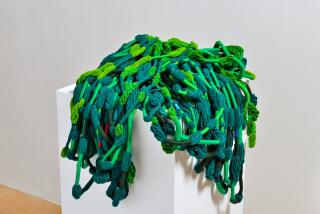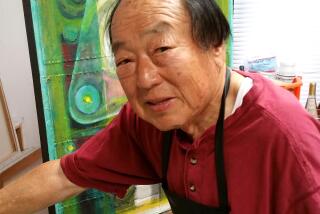Ruth Asawa, artist known for intricate wire sculptures, dies at 87
- Share via
SAN FRANCISCO -- Ruth Asawa, a San Francisco sculptor recognized as a major post-WWII American modernist for her intricate hanging wire creations, died early Tuesday, her daughter Addie Lanier said. She was 87.
Asawa, who as a Japanese American woman navigated decades of discrimination as well as internment during the war, had a lasting effect on the arts in San Francisco, where she moved in 1949 to join her husband, architect Albert Lanier.
In addition to breaking the barriers of craft with her crocheted wire sculptures, Asawa dedicated herself to fostering the arts for local youth and adults. She co-founded the Alvarado Arts Workshop for schoolchildren in 1968 and followed up in 1982 by building the San Francisco School of the Arts, a public arts high school that was renamed in her honor two years ago.
PHOTOS: Notable deaths of 2013
The communal projects she orchestrated dot San Francisco’s landscape – among them “Hyatt Fountain on Union Square,” which was crafted in 1973 with the help of hundreds of children who created neighborhood vignettes from dough. The use of dough was meant to celebrate the artistic potential of everyday – and inexpensive -- objects. Asawa then cast the work in bronze
“If you want to say one half of her life was devoted to the creation or art, the other side was a lifelong advocacy of art education as an empowering experience for adults and children,” said Timothy Anglin Burgard, curator of American art at the Fine Arts Museums of San Francisco, which include the De Young, where 15 of Asawa’s world-renowned wire sculptures are displayed, and the Legion of Honor.
“She was in a very real sense knitting the community together with the communal public fountain,” Burgard said, “ mirroring the city back to itself and saying we are a community.”
FULL COVERAGE: 2013 Spring arts preview
The Union Square fountain recently triggered a controversy when Apple Inc. proposed removing it to make way for a new store. An outcry ensued, and San Francisco Mayor Ed Lee directed the Planning Department to work out a compromise. The fountain will now be preserved.
“It is part of San Francisco history and will remain so,” a mayoral spokeswoman said Tuesday.
In a statement, Lee lamented Asawa’s death, calling the former city arts commissioner and trustee of the Fine Arts Museums of San Francisco “a true champion of the arts for our entire City.”
Asawa was born in Norwalk in 1926 to Japanese truck farmer parents. In 1942, her family was interned at the Santa Anita racetrack, living there for six months before being shipped to a more permanent camp in Rohwer, Ark.
PHOTOS: Arts and culture in pictures by The Times
Her efforts to become a schoolteacher were thwarted by anti-Japanese sentiment and she ended up at the pioneering Black Mountain College, in North Carolina, where her teachers included the painter Josef Albers, dancer Merce Cunningham, and architect/inventor Buckminster Fuller. She also met her husband there.
Her wire sculptures, which sway gently in air currents and cast kinetic shadows, earned her a global reputation – several have recently sold at auction houses for more than $1 million.
“She is now universally recognized as an American postwar modernist, not simply as a Bay Area artist,” Burgard said.
Her “beautiful looped wire mesh sculptures… transcend the barriers she faced as an as Asian American woman artist working with craft techniques,” he said. “She lived to see all of those categories and definitions challenged and redefined.”
CRITICS’ PICKS: What to watch, where to go, what to eat
Asawa held on to her best work over decades and in 2005 donated 15 of the wire pieces to the De Young for its inaugural opening. They are displayed in the lobby of the education tower, and Burgard said “every visitor to the museum – and that includes numerous [museum] directors, curators and critics -- have been taken with the sheer beauty of that installation.” He likened passing through the space to walking through “a giant kelp forest.”
“They are pioneering and revolutionary in their form in the same way that Alexander Calder as a sculptor invented a new kinetic form,” he added.
In addition to her daughter Addie, Asawa is survived by her children Xavier Lanier, Aiko Cuneo, Hudson Lanier and Paul Lanier. Her son Adam Lanier predeceased her.
A complete obituary will follow at latimes.com/obits.
ALSO:Natalie de Blois, 92, pioneering female architect
Walter De Maria, 77, known for large art installations
Dolly Bright Silliman, 98, donated major artworks to LACMA
More to Read
Start your day right
Sign up for Essential California for the L.A. Times biggest news, features and recommendations in your inbox six days a week.
You may occasionally receive promotional content from the Los Angeles Times.







